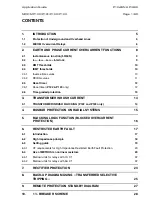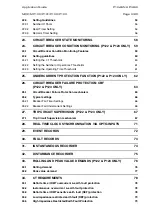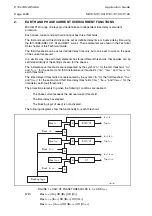
Application Guide
P12x/EN AP/A96
MiCOM P120/P121/P122/P123
Page 5/80
1. INTRODUCTION
1.1
Protection of Underground and Overhead Lines
The secure and reliable transmission and distribution of power within a network is heavily
dependent upon the integrity of underground cables and overhead lines, which link the
various sections of the network together. Therefore the associated protection system must
also provide both secure and reliable operation.
The most common fault conditions, on underground cables and overhead lines, are short
circuit faults. These faults may occur between the phase conductors but will most often
involve one or more phase conductor becoming short-circuited to earth.
Faults caused by short circuits require the fastest faulted conductor clearance times but at
the same time allowing for suitable co-ordination with other downstream protection devices.
Fault sensitivity is an issue common to all voltage levels. For transmission systems, tower-
footing resistance can be high. Also, high resistance faults might be prevalent where lines
pass over sandy or rocky terrain. Fast, discriminative faulted conductor clearance is required
for these fault conditions.
The effect of fault resistance is more pronounced on lower voltage systems, resulting in
potentially lower fault currents, which in turn increases the difficulty in the detection of high
resistance faults. In addition, many distribution systems use earthing arrangements designed
to limit the passage of earth fault current.
Earthed methods as such as using resistance, Petersen coil or insulated systems make the
detection of earth faults arduous. Special protection equipment is often used to overcome
these problems.
Nowadays, the supply continuity in the energy distribution is of paramount importance.
On overhead lines most of faults are transient or semi-permanent in nature.
In order to increase system availability multi-shot autoreclose cycles are commonly used in
conjunction with instantaneous tripping elements. For permanent faults it is essential that
only the faulted section of the network is isolated. High-speed, discriminative fault clearance
is therefore a fundamental requirement of any protection scheme on a distribution network.
Power transformers are installed at all system voltage levels and have their own specific
requirements with regard to protection. In order to limit the damage incurred by a transformer
under fault conditions, fast clearance of the windings with phase to phase and phase to earth
faults is a primary requirement.
Damage to electrical plant equipment such as transformers, cables and lines may also be
incurred by excessive loading conditions, which leads directly to overheating of the
equipment and subsequent degradation of their insulation. To protect against such fault
conditions, protective devices require thermal characteristics too.
Uncleared faults, arising either from the failure of the associated protection system or of the
switchgear itself, must also be considered. The protection devices concerned should be
fitted with logic to deal with breaker failure and relays located upstream must be able to
provide adequate back-up protection for such fault conditions.
Other situations may arise on overhead lines, such as broken phase conductors.
Traditionally, a series fault has been difficult to detect.
With today's digital technology, it is now possible to design elements, which are responsive
to such unbalanced system, conditions and to subsequently issue alarm and trip signals.
On large networks, time co-ordination of the overcurrent and earth fault protection relays can
often lead to problematic grading situations or, as is often the case, excessive fault
clearance times. Such problems can be overcome by relays operating in blocked overcurrent
schemes.
Summary of Contents for MiCom P120
Page 1: ...MiCOM P120 P121 P122 P123 Overcurrent Relays Version 11 Technical Guide P12X EN T A96...
Page 2: ......
Page 4: ...P12x EN T A96 Technical Guide Contents Page 2 2 MiCOM P120 P121 P122 P123 BLANK PAGE...
Page 13: ...Introduction P12x EN IT A96 MiCOM P120 P121 P122 P123 INTRODUCTION...
Page 14: ......
Page 16: ...P12x EN IT A96 Introduction Page 2 8 MiCOM P120 P121 P122 P123 BLANK PAGE...
Page 22: ...P12x EN IT A96 Introduction Page 8 8 MiCOM P120 P121 P122 P123 BLANK PAGE...
Page 24: ......
Page 35: ...User Guide P12x EN FT A96 MiCOM P120 P121 P122 P123 USER GUIDE...
Page 36: ......
Page 40: ...P12x EN FT A96 User Guide Page 4 72 MiCOM P120 P121 P122 P123 BLANK PAGE...
Page 108: ...P12x EN FT A96 User Guide Page 72 72 MiCOM P120 P121 P122 P123 BLANK PAGE...
Page 109: ...Menu Content Tables P12x EN HI A96 MiCOM P120 P121 P122 P123 MENU CONTENT TABLES...
Page 110: ......
Page 112: ...P12x EN HI A96 Menu Content Tables Page 2 68 MiCOM P120 P121 P122 P123 BLANK PAGE...
Page 180: ......
Page 221: ...Application Guide P12x EN AP A96 MiCOM P120 P121 P122 P123 APPLICATION GUIDE...
Page 222: ......
Page 226: ...P12x EN AP A96 Application Guide Page 4 80 MiCOM P120 P121 P122 P123 BLANK PAGE...
Page 302: ...P12x EN AP A96 Application Guide Page 80 80 MiCOM P120 P121 P122 P123 BLANK PAGE...
Page 304: ......
Page 306: ......
Page 368: ......
Page 370: ...P12x EN CT A96 Communications COURIER DATABASE Page 2 248 MiCOM P120 P121 P122 P123 BLANK PAGE...
Page 514: ...P12x EN CT A96 Communications COURIER DATABASE Page 146 248 MiCOM P120 P121 P122 P123...
Page 516: ......
Page 518: ...P12x EN CT A96 Communications IIEC 60870 5 103 Page 2 248 MiCOM P120 P121 P122 P123 BLANK PAGE...
Page 536: ...P12x EN CT A96 Communications IEC 60870 5 103 Page 20 248 MiCOM P120 P121 P122 P123...
Page 538: ......
Page 540: ...P12x EN CT A96 Communications DNP 3 0 Database Page 2 248 MiCOM P120 P121 P122 P123 BLANK PAGE...
Page 554: ......
Page 573: ...Connection Diagrams P12x EN CO A96 MiCOM P120 P121 P122 P123 CONNECTION DIAGRAMS...
Page 574: ......
Page 580: ......
Page 582: ...P12x EN RS A96 Commissioning Test Record Sheets Page 2 60 MiCOM P120 P121 P122 P123 BLANK PAGE...
Page 642: ......
Page 667: ......
















































